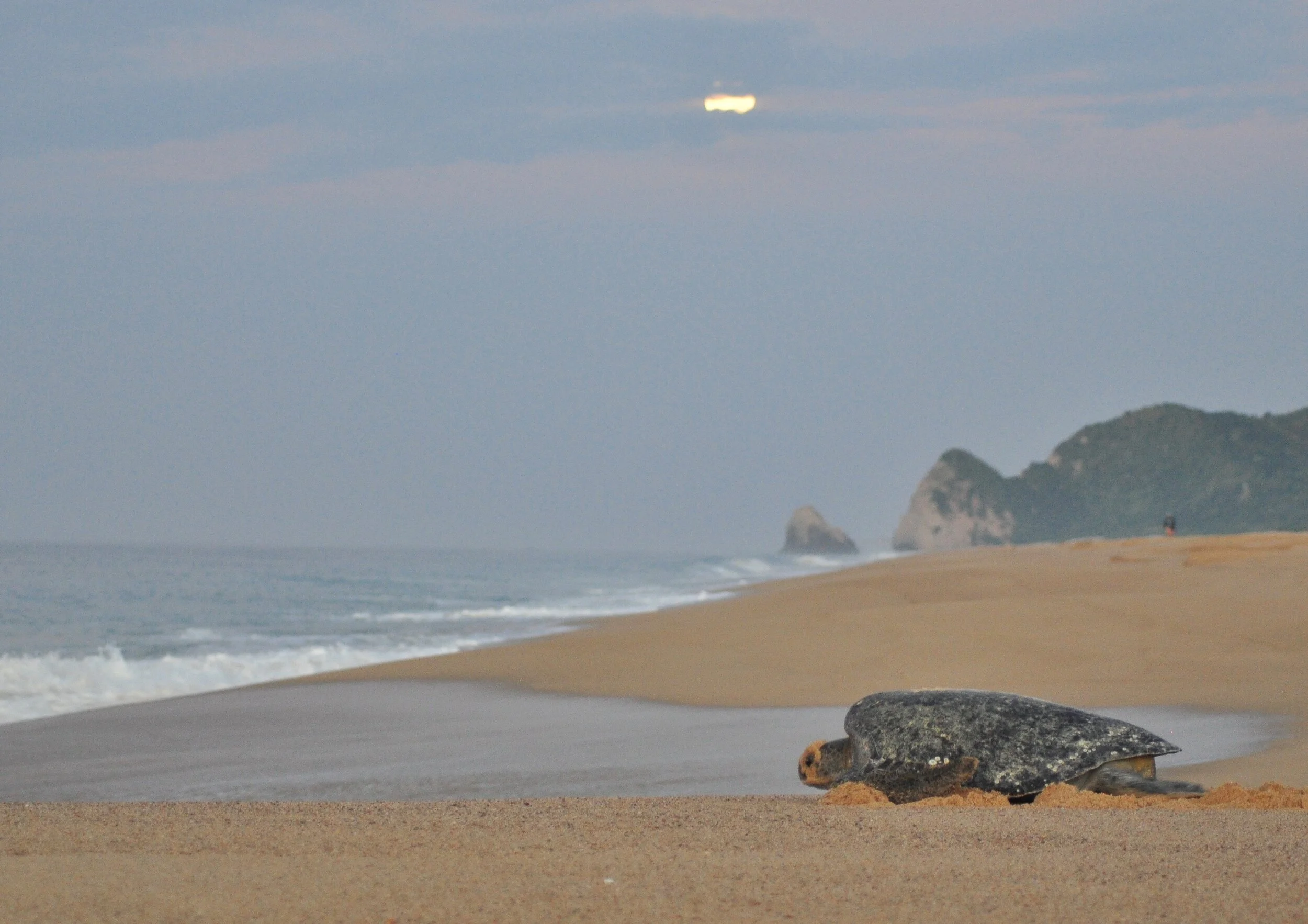I’ve been working with sea turtle conservation partners for the past decade to provide support to important nesting beaches around the world. I’ve worked personally on four different nesting beaches in Costa Rica and have visited dozens of others. I’ve never seen anything like the sheer avalanche of sea turtles and hatchlings that Colola Beach in the Mexican state of Michoacan, which is known as “The black sea turtle capital of the world.”
I just wrapped up bringing two groups of a total of 25 people to volunteer on this extraordinary beach. The numbers are overwhelming; 46,000 nests last year with more than 2 million hatchlings alone. Over the ten days that I spent at this beach with these groups, there were more than 3,200 nests and roughly 20,000 hatchlings. The beach is one long undulation of holes made by the nesting turtles.
Walk along the beach during the day and you’ll see them nesting close to shore. Look down and you might come across some straggler hatchlings from a natural nest. Head to the hatchery at dusk and you’ll find little heads popping out of several nests. Wait an hour and you’ll have a dozen nests hatching at the same time, where hundreds of baby turtles are released to the water at the same time. Walk a couple hundred feet onto the nesting beach around 9 pm and most nights during this time of year, you’ll find five or ten females right there in front of the hatchery nesting. One night, while watching a female nest, a natural nest hatched about two feet away, dozens of little hatchlings scrambling around my feet in a matter of minutes. Get up at dawn and you’ll usually see at least a couple of late-night nesting turtles returning to the ocean.
The situation wasn’t always this way at Colola. After decades of harvesting of the adults and eggs for export, this population crashed. What once numbered in the tens of thousands, this population had just an estimated 500 females in the late 90’s. But the fruit of efforts starting in the late 70’s and early 80’s by biologist Kim Clifton and researchers from the University of Michoacan started paying off. With each year the number of nests climbed steadily, from a low of 533 in 1999 to now more than 40,000 per year, a stunning recovery.
Researchers including Carlos Delgado, who started working at Colola 30 years ago, began working with the local Nahua community, an indigenous group that lives along this stretch of coast. They hired adults to help monitor the beach and paid kids to bring nests to the hatchery to be protected, many of whom now work on the project as adults. Once the hatchlings had time to grow, their numbers rebounded and this is now one of the biggest sea turtle success stories in the world.
These two trips were organized as an opportunity for our past travelers to have a special experience on a beach that our Billion Baby Turtles program has been supporting since 2014. A total of 25 people from the US and Canada spent five nights each at the research station to see and work with the black sea turtles. And turtles did they see!
The turtle routine started in the early evening; as the sun set, the hatchlings would start emerging from nests in the hatchery. Batch by batch, our volunteers brought them to release near the water, leaving them to cover the last ten or twenty feet on their own. Around nine, groups would head out to the beach to study the adult females, collecting information on their length, where they nested, and their tag numbers as well as collecting eggs to bring to the hatchery.
Each day, we headed to nearby beaches as beautiful as any in Mexico. Hanging out under thatch roof shelters, we took turns swimming and snorkeling, swapping stories of visits to other nesting beaches, and enjoying local snacks and beverages. Each group visited a family in the nearby town of Maruata that made ceramic art by hand, digging the mud from around their houses, refining it, shaping it into various shapes (including turtles of course) and then firing them in their kiln for hours to finish them. Another day, we took a nature walk with a local Nahua elder who showed us plants used to cure infections, for upset stomach, healing wounds, and more. We also learned about native trees used for wood and natural dyes. Among the wildlife we saw were iguanas, egrets, ibis, a baby hummingbird, and several colorful butterflies. We also visited the Finger of God rock formation in Maruata, a gorgeous stretch of coastline.
Hummingbird fledgling
Finger of God in Maruata
Our second group coincided with one of the largest celebrations in Mexico, the “Dia de la Virgen de Guadalupe” (Virgin of Guadalupe Day), December 12th. The original story goes back to early colonization in 1531, when a pilgrim named Juan Diego saw the apparition of the Virgin Mary, who told him to go to Mexico City (then Tenoctilan) and tell the bishop at the church. When the didn’t believe him, he returned to the pass and spoke again to the virgin to get proof of her existence. The virgin told him to bring rose petals bound up in his clothes to the church; when he dropped them in front of the bishop, the image of the virgin was left in the imprint of his clothes. This frock can still be seen at the basilica named in her honor in Mexico City.
We were invited to visit the beginning of the festivities in a nearby Nahua town. Loud fireworks went off as we arrived, a creative way to call surrounding locals to the party. A group of girls dressed in traditional dress did a series of dances, one right into the other without breaking a sweat in the intense heat. Hundreds of pounds of corn meal were expertly being converted into tortillas as we watched (pro tip, rub lime juice and salt on tortillas before you eat them).
Our second group had the opportunity to participate in research in the hatchery, helping to dig up nests two days after they hatched. The remaining eggs, shells, and hatchlings (some surviving, some not) are analyzed to determine how well the hatchery was functioning. Once the hatchlings were released, we were done our turtle work for the week.
Due to conflict in other parts of Michoacan state, tourism declined dramatically in this part of Mexico, though the beach area remains safe. The economic impact of these two groups on the community is significant; more than US $12,000 was spent in and around Colola, an area with few economic opportunities. In addition, our Billion Baby Turtles program gave a $10,000 grant given to the project by, which was partially funded by this trip. Our two groups also completed roughly 125 volunteer shifts in the ten days.
Spending two weeks at Colola was a profound experience. Seeing a truly successful conservation project at work is energizing and holds many lessons for projects around the world trying to duplicate their accomplishments.
Learn more:







